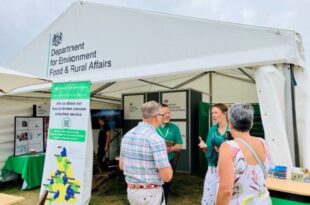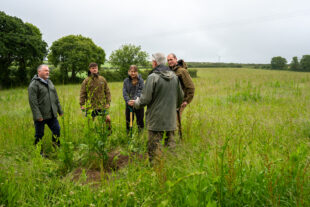https://defrafarming.blog.gov.uk/create-scrub-and-scrub-mosaics/
Create scrub and scrub mosaics
The guidance on this page is for SFI pilot participants only. Please visit GOV.UK for the official Sustainable Farming Incentive scheme guidance.
Find out how land managers can create scrub and scrub mosaics to provide food and shelter for wildlife.
If you’re completing this action as part of the Sustainable Farming Incentive pilot, how you do it is up to you.
The advice on this page can help you get better environmental and business benefits, but you do not have to follow it to get paid.
About scrub and scrub mosaics
Scrub includes all growth stages of native shrubs, from scattered bushes to closed canopy vegetation. Good scrub has a diverse structure with different heights, though it’s usually less than 5 metres tall.
When patches of scrub grow in habitats like grassland, it’s described as a mosaic.
Scrub provides wildlife with food and shelter and has the greatest benefit where there is:
- a variety of native shrub species like hawthorn, blackthorn and hazel
- a range of shrub heights, ages and structures
- scrub edges that flow naturally into surrounding vegetation
- scrub and other vegetation, like grasses and herbs, that flower and set seed
- occasional open grown trees developing through thorny scrub and bramble
You can create scrub on a range of soil types. It can improve landscape in areas where nutrient enrichment of soil stops other habitats developing. For example, you can create areas of scrub where species-rich grassland is hard to establish.
You can develop more complex scrub mosaics on larger areas, to provide different environments for more species. Even small areas of scrub scattered across a landscape provide resources for wildlife.
Benefits of creating scrub and scrub mosaics
Creating scrub can:
- increase the species variety of invertebrates, reptiles, amphibians, small mammals and birds
- create habitats to support natural predators of crop pests and diseases
- provide forage for livestock that lasts later in the year compared to other grazing habitats, like grassland
- help lichens to grow, which provides food and nest material for wildlife
- boost populations of pollinators
- help remove carbon from the atmosphere
- maintain carbon-rich soils
How to create scrub and scrub mosaics
Choose the right location
Scrub and scrub mosaics are valuable in areas dominated by arable land and agriculturally improved grassland, where food and shelter for wildlife are in short supply.
Scrub will grow in unmanaged areas close to areas of trees and shrubs, where there is an existing seed source. You can create scrub:
- alongside hedgerows
- alongside a wood edge, to create a transition between wood and open ground
- on land which is difficult to graze
- to buffer water bodies and watercourses
You can create larger areas of scrub or scrub mosaic in field corners where two or more hedges meet.
Aim for scrub and scrub mosaics across 2% to 10% of the farmed landscape.
Avoid creating scrub and scrub mosaics on land that:
- is already important for wildlife, like species-rich grassland
- supports or is close to land important for wading birds like lapwing or curlew
- protects sensitive historic or geodiversity features
If your land is part of a Site of Special Scientific Interest (SSSI), you must find out if you need consent before you plant scrub or allow it to develop. Use MAGIC to check if your land is on an SSSI.
If you plan to create larger areas of scrub in or alongside woodland, find out if you need an Environmental Impact Assessment. You can also read the UK Forestry Standard on sustainable forest management.
Contact your local Forestry Commission area office if you plan to create closed canopy woodland.
Allow scrub to develop naturally
The simplest way to create scrub and scrub mosaics is to allow them to develop naturally (natural regeneration). It works best where existing areas of scrub, like hedgerows and woodland scrub, can spread. You’ll only need to remove livestock or stop cultivation.
Once scrub is established, you can use livestock and wildlife to graze and browse large areas. This will help maintain scrub and allow it to develop within a mosaic.
If many species of trees establish, you could create or extend woodland. Allow native scrub species to develop that will be less than 5 metres tall. These can include:
- hawthorn
- bramble
- blackthorn
- hazel
- dog and field rose
- low growing willow species
On calcareous soils this could be:
- box
- privet
- buckthorn
- dogwood
Acid soils will often have gorse or broom.
Planting
You should only need to plant if natural regeneration is not likely to work, for example where there is:
- no local seed source, like trees or scrub that are left to set seed
- a lot of dense, rank (overgrown and tussocky) vegetation like bracken
Planting can also help if you want to increase the diversity of shrub species.
Plant between November and March and choose a wide range of native species that suit the site. Planting nursery-grown stock is the easiest method, but it can be expensive.
It’s important the plants and trees you use are free from pests and disease, and preferably grown in the UK. Where possible use plants from Plant Healthy certified nurseries. Plant Healthy is a scheme designed to make sure people who grow and handle plants have suitable biosecurity standards in place. You can use Plant Healthy to check if the nurseries you buy your plants and trees from are certified.
You should:
- plant in clumps
- leave unplanted gaps to create open ground as part of the mosaic
- mix species randomly
- use hand tools to plant scrub, like spades
Do not:
- plant in rows, as this can create wind tunnels
- plough or cultivate
Scallop the edges of the scrub or scrub mosaic. To achieve this, plant patches of shrub in semi-circles and create areas of open ground in between.
Spreading seed
On large areas of cultivated ground or open landscape with no seed source, spread seed to establish scrub. This is cheaper than planting, but it will take longer.
Layering and cuttings
If you have small amounts of mature scrub, you may be able to use cuttings or layering.
Layering involves pegging branches into the soil and making a slit on the underside of the branch, using a knife or billhook. The branches then take root.
After around 3 months, when the layer has set strong roots, you can cut the stem from the parent close to the layer.
Use this method for species like:
- bramble
- dogwood
- hazel
- dog and field rose
- types of willow
Try to use locally sourced cuttings. They grow quickly, and provide good cover and food sources.
Do not apply fertilisers or manure. An increase of nutrients will prevent a wide range of grass species growing in open areas.
Protect shrubs from browsing
You’ll need to protect shrubs from animals who may eat them, including livestock, deer and rabbits.
You can protect small numbers of shrubs with spiral guards or tubes. Find out how to use spiral guards sustainably and reduce the use of plastic.
Fence larger areas of scrub, and any smaller areas you see animals browsing. You can choose permanent or temporary fencing to match the management of your land. For example, you could use permanent fencing on land which is grazed for longer periods. Read about how to apply for grants for capital items, including fencing.
Find out how to maintain scrub and scrub mosaics once it’s established.
What successful scrub and scrub mosaics look like
There’ll be diverse scrub over 2% to 10% of the farmed landscape, as either:
- scattered patches throughout the landscape
- part of a larger mosaic with grassland or other habitats
You’ll see:
- an established range of 3 or more native species of shrub at different heights
- basking reptiles and invertebrates in open areas between scrub
- caterpillars of moths like orchard ermine, pear leaf blister and light emerald feeding on hawthorn trees
- farmyard birds such as turtle dove, yellowhammer and corn bunting



